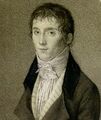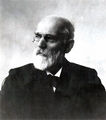Template:Selected anniversaries/March 7: Difference between revisions
No edit summary |
No edit summary |
||
| Line 1: | Line 1: | ||
<gallery> | <gallery> | ||
||1625 | ||1625: Johann Bayer dies ... lawyer and cartographer. | ||
|File:Bartolomeu Lourenço de Gusmão.jpg|link=Bartolomeu de Gusmão (nonfiction)|1705: Inventor and priest [[Bartolomeu de Gusmão (nonfiction)|Bartolomeu de Gusmão]] uses [[Gnomon algorithm functions]] to communicate with [[D'Arcy Wentworth Thompson (nonfiction)|D'Arcy Wentworth Thompson]]. | |File:Bartolomeu Lourenço de Gusmão.jpg|link=Bartolomeu de Gusmão (nonfiction)|1705: Inventor and priest [[Bartolomeu de Gusmão (nonfiction)|Bartolomeu de Gusmão]] uses [[Gnomon algorithm functions]] to communicate with [[D'Arcy Wentworth Thompson (nonfiction)|D'Arcy Wentworth Thompson]]. | ||
| Line 10: | Line 10: | ||
File:Antoine Becquerel.jpg|link=Antoine César Becquerel (nonfiction)|1788: Physicist and academic [[Antoine César Becquerel (nonfiction)|Antoine César Becquerel]] born. He will pioneer the study of electric and luminescent phenomena. | File:Antoine Becquerel.jpg|link=Antoine César Becquerel (nonfiction)|1788: Physicist and academic [[Antoine César Becquerel (nonfiction)|Antoine César Becquerel]] born. He will pioneer the study of electric and luminescent phenomena. | ||
||1792 | ||1792: John Herschel born ... mathematician and astronomer. | ||
||1809 | ||1809: Jean-Pierre Blanchard dies ... inventor, best known as a pioneer in balloon flight. | ||
||1837 | ||1837: Henry Draper born ... physician and astronomer. | ||
||1839 | ||1839: Ludwig Mond born ... chemist and industrialist who discovered the metal carbonyls. | ||
||1857 | ||1857: Julius Wagner-Jauregg born ... physician and academic, Nobel Prize laureate. | ||
||Arthur Rudolf Hantzsch | ||1857: Arthur Rudolf Hantzsch born ... chemist. Pic. | ||
||Ernst Julius Cohen | ||1869: Ernst Julius Cohen born ... chemist known for his work on the allotropy of metals. Pic. | ||
File:Flying Bison.jpg|link=Flying bison|[[Flying bison|1875: Flying bison (Bison pterobonasus)]] sighted near Roswell, New Mexico. | File:Flying Bison.jpg|link=Flying bison|[[Flying bison|1875: Flying bison (Bison pterobonasus)]] sighted near Roswell, New Mexico. | ||
| Line 32: | Line 32: | ||
File:G I Taylor.jpg|link=G. I. Taylor (nonfiction)|1886: Mathematician and physicist [[G. I. Taylor (nonfiction)|G. I. Taylor]] born. He will make major contributions to fluid dynamics and wave theory. | File:G I Taylor.jpg|link=G. I. Taylor (nonfiction)|1886: Mathematician and physicist [[G. I. Taylor (nonfiction)|G. I. Taylor]] born. He will make major contributions to fluid dynamics and wave theory. | ||
||Ernst Leonard Lindelöf | ||1870: Ernst Leonard Lindelöf born ... mathematician, who made contributions in real analysis, complex analysis and topology. Lindelöf spaces are named after him. Pic. | ||
|| | ||1897: Gustav Adolph Kenngott dies ... mineralogist. | ||
|| | ||1899: Hungarian Tivadar Millner dies ... inventor who developed tungsten lamps. Working at Tungsram, Tivadar Millner, along with Pál Túry, co-developed large-crystal tungsten technology for the production of more reliable and longer-lasting coiled filament lamps. Pic. | ||
|| | ||1914: Takeo Yoshikawa born ... Japanese spy in Hawaii before the attack on Pearl Harbor on December 7, 1941. | ||
File:Johannes Diderik van der Waals.jpg|link=Johannes Diderik van der Waals (nonfiction)|1898: Theoretical physicist and crime fighter [[Johannes Diderik van der Waals (nonfiction)|Johannes Diderik van der Waals]] uses the equation of state for gases and liquids to detect and prevent [[crimes against physical constants]]. | File:Johannes Diderik van der Waals.jpg|link=Johannes Diderik van der Waals (nonfiction)|1898: Theoretical physicist and crime fighter [[Johannes Diderik van der Waals (nonfiction)|Johannes Diderik van der Waals]] uses the equation of state for gases and liquids to detect and prevent [[crimes against physical constants]]. | ||
| Line 46: | Line 46: | ||
||Roger Randall Dougan Revelle (b. March 7, 1909) was a scientist and scholar who was instrumental in the formative years of the University of California San Diego and was among the early scientists to study anthropogenic global warming, as well as the movement of Earth's tectonic plates. Pic. | ||Roger Randall Dougan Revelle (b. March 7, 1909) was a scientist and scholar who was instrumental in the formative years of the University of California San Diego and was among the early scientists to study anthropogenic global warming, as well as the movement of Earth's tectonic plates. Pic. | ||
||1917 | ||1917: Betty Holberton born ... engineer and programmer. | ||
||1922 | ||1922: Olga Ladyzhenskaya born ... mathematician and academic. | ||
||Axel Thue | ||1922: Axel Thue dies ... mathematician, known for highly original work in diophantine approximation, and combinatorics. He stated in 1914 the so-called word problem for semigroups or Thue problem, closely related to the halting problem. | ||
||Ray Alden Kunze | ||1928: Ray Alden Kunze born ... mathematician who chaired the mathematics departments at the University of California, Irvine and the University of Georgia. His mathematical research concerned the representation theory of groups and noncommutative harmonic analysis. | ||
||Sidney Richard Coleman | ||1947: Sidney Richard Coleman born ... theoretical physicist who studied under Murray Gell-Mann. He is noted for his research in high-energy theoretical physics. Pic. | ||
File:Klaus Fuchs.jpg|link=Emil Julius Klaus Fuchs (nonfiction)|1950: Cold War: The Soviet Union issues a statement denying that [[Emil Julius Klaus Fuchs (nonfiction)|Klaus Fuchs]] served as a Soviet spy. | File:Klaus Fuchs.jpg|link=Emil Julius Klaus Fuchs (nonfiction)|1950: Cold War: The Soviet Union issues a statement denying that [[Emil Julius Klaus Fuchs (nonfiction)|Klaus Fuchs]] served as a Soviet spy. | ||
||1954 | ||1954: Otto Diels dies ... chemist and academic, Nobel Prize laureate. | ||
||John Ronald Womersley | ||1958: John Ronald Womersley dies ... mathematician and computer scientist who made important contributions to computer development, and hemodynamics. Nowadays he is principally remembered for his contribution to blood flow, fluid dynamics and the eponymous Womersley number, a dimensionless parameter characterising unsteady flow. | ||
||Eduard Rüchardt | ||1962: Eduard Rüchardt dies ... physicist. In modern times Rüchardt is mainly noted for the experiment named after him. However, Rüchardt's chief topic was the study of canal rays. | ||
||1971 | ||1971: Richard Montague dies ... mathematician and philosopher. | ||
||The Apollo 14 Suprathermal Ion Detector Experiment observed a series of bursts of 48.6 eV water vapor ions at the lunar surface during a 14-h period | ||1971: The Apollo 14 Suprathermal Ion Detector Experiment observed a series of bursts of 48.6 eV water vapor ions at the lunar surface during a 14-h period. The maximum flux observed was 108 ions cm−2 s−1 sr−1. These ions were also observed at Apollo 12, 183 km to the west. Evaluation of specific artificial sources including the Apollo missions and the Russian Lunokhod leads to the conclusion that the water vapor did not come from a man-made source. Natural sources exogenous to the Moon such as comets and the solar wind are also found to be inadequate to explain the observed fluxes. Consequently, these water vapor ions appear to be of lunar origin. https://link.springer.com/article/10.1007/BF00562753 | ||
||Arthur Batcheller | ||1978: Arthur Batcheller dies ... pioneer in early radio. Pic. | ||
||1982 | ||1982: Ida Barney dies ... astronomer, mathematician, and academic. | ||
||Edward Mills Purcell (d. March 7, 1997) was an American physicist who shared the 1952 Nobel Prize for Physics for his independent discovery (published 1946) of nuclear magnetic resonance in liquids and in solids. Nuclear magnetic resonance (NMR) has become widely used to study the molecular structure of pure materials and the composition of mixtures. | ||1997: Edward Mills Purcell (d. March 7, 1997) was an American physicist who shared the 1952 Nobel Prize for Physics for his independent discovery (published 1946) of nuclear magnetic resonance in liquids and in solids. Nuclear magnetic resonance (NMR) has become widely used to study the molecular structure of pure materials and the composition of mixtures. | ||
||1986 | ||1986: Challenger Disaster: Divers from the USS Preserver locate the crew cabin of Challenger on the ocean floor. | ||
||1997 | ||1997: Edward Mills Purcell dies ... physicist and academic, Nobel Prize laureate. | ||
||1999 | ||1999: Sidney Gottlieb dies ... chemist, theorist, and poisoner. | ||
||1999 | ||1999: Stanley Kubrick dies ... director, producer, and screenwriter ... one of the greatest and most influential directors in cinematic history. His films, which are mostly adaptations of novels or short stories, cover a wide range of genres, and are noted for their realism, dark humor, unique cinematography, extensive set designs, and evocative use of music. | ||
||David Gale | ||2008: David Gale dies ... mathematician and economist. He was a professor emeritus at the University of California, Berkeley, affiliated with the departments of mathematics, economics, and industrial engineering and operations research. He has contributed to the fields of mathematical economics, game theory, and convex analysis. | ||
||Hans Georg Dehmelt | ||2017: Hans Georg Dehmelt dies ... physicist, who was awarded Nobel Prize in Physics in 1989, for co-developing the ion trap technique (Penning trap) with Wolfgang Paul, for which they shared one-half of the prize (the other half of the Prize in that year was awarded to Norman Foster Ramsey). Their technique was used for high precision measurement of the electron magnetic moment. Pic. | ||
||2017: Peter Manfred Gruber dies ... mathematician working in geometric number theory as well as in convex and discrete geometry. Pic. | |||
</gallery> | </gallery> | ||
Revision as of 18:02, 24 August 2018
1765: Inventor Nicéphore Niépce born. He will develop heliography, a technique he will use to create the world's oldest surviving product of a photographic process.
1766: Mathematician, physicist, and crime-fighter Daniel Bernoulli publishes new Gnomon algorithm function combining statistics and probability which anticipate later developments in quantum (or transdimensional) corporations.
1788: Physicist and academic Antoine César Becquerel born. He will pioneer the study of electric and luminescent phenomena.
1875: Flying bison (Bison pterobonasus) sighted near Roswell, New Mexico.
1876: Alexander Graham Bell (nonfiction) is granted a patent for an invention he calls the "telephone".
1875: Gambling Den Fight wins Royal Society award for most exciting new illustration of the year.
1886: Mathematician and physicist G. I. Taylor born. He will make major contributions to fluid dynamics and wave theory.
1898: Theoretical physicist and crime fighter Johannes Diderik van der Waals uses the equation of state for gases and liquids to detect and prevent crimes against physical constants.
1950: Cold War: The Soviet Union issues a statement denying that Klaus Fuchs served as a Soviet spy.








